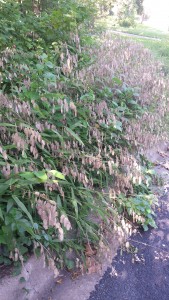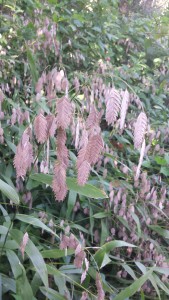 I pass by this large patch of Inland Sea Oat (Chasmanthium latifolium) everyday on my way to St. Edward’s. This is the same native grass that Eric, Abbie, and myself are using to oversow our experimental plots with in the hopes that their growth will suppress the Chinese and Japanese privet populations. This is a 2-4 ft., clump-forming, perennial grass bearing large, drooping, oat-like flower spikelets. Their leaves look very similar to bamboo leaves and will turn yellow during the fall. Inland Sea Oat is very popular as a low-maintenance shade grass. This grass can grow to be 2 feet tall within a few months of sprouting its first leaves. As the seeds mature, they will turn from green to ivory to brown and eventually fall off, or are eaten. The seeds are eaten by small mammals and granivorous birds, the leaves provide graze for mammals, and the stems and leaves are used as nesting material by birds. Inland Sea Oat is also the larval host plant for a few butterfly species: pepper & salt skipper butterfly, bells road side skipper butterfly, and the bronzed roadside skipper butterfly.
I pass by this large patch of Inland Sea Oat (Chasmanthium latifolium) everyday on my way to St. Edward’s. This is the same native grass that Eric, Abbie, and myself are using to oversow our experimental plots with in the hopes that their growth will suppress the Chinese and Japanese privet populations. This is a 2-4 ft., clump-forming, perennial grass bearing large, drooping, oat-like flower spikelets. Their leaves look very similar to bamboo leaves and will turn yellow during the fall. Inland Sea Oat is very popular as a low-maintenance shade grass. This grass can grow to be 2 feet tall within a few months of sprouting its first leaves. As the seeds mature, they will turn from green to ivory to brown and eventually fall off, or are eaten. The seeds are eaten by small mammals and granivorous birds, the leaves provide graze for mammals, and the stems and leaves are used as nesting material by birds. Inland Sea Oat is also the larval host plant for a few butterfly species: pepper & salt skipper butterfly, bells road side skipper butterfly, and the bronzed roadside skipper butterfly.
In the riparian ecosystem at Wild Basin, Inland Sea Oat is a favorable species to use the oversowing method with because this species is shade-tolerant, re-seeds easily, and can expand aggressively within a couple of years. They also help to stabilize the sediment and prevent soil erosion. iNaturalist Observation. 
Source for Inland Sea Oat info.